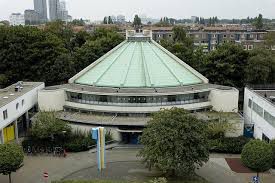

Designed by the architects Brinkman and van der Vlugt in 1928, Cinetol was built as a meeting place for the Theosophical Society, a religious and philosophical movement founded by the Russian Madame Blavatsky, which was particularly popular around the turn of the 20th century. For example, the abstract painter Piet Mondrian, who briefly lived and worked next to the Sarphatipark, was one of the notable members of this movement.
The building was re-christened when it became a cinema during the war, a function it fulfilled until the mid-1980s. Since 1985 it has served as a branch of the city's public library. The architectural style of the Cinetol is called the New Construction or the New Objectivity. The philosophy behind this architectural style encouraged the use of modern technology so as to create the most efficient designs which would, in turn, serve the function of the building most optimally. The most recognizable stylistic feature of this style are the glass facades divided by thin steel sections. For instance, the Van Nelle tobacco plant in Rotterdam, drafted by the same architects, is a another typical example.
While this particular feature is missing in Cinetol, the building is still considered to be a fine example of the New Objectivity. The closed character of the space was chosen deliberately because too transparent of a space with windows would take attention away from the speakers giving talks at the venue. For this reason, the vertical light slits were positioned in such a way that the speaker stood illuminated in beams of light. The light also entered from above, through a light well in the rafters of the roof. This is entirely in line with the Theosophical premise that wisdom was received by the light from above and could, in turn, be passed on to the audience, who hence also became enlightened. Since the purpose of the building was optimally served by its design, it fits seamlessly into the ideas behind the New Objectivity.